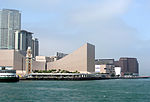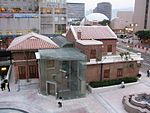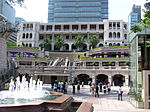Clock Tower, Hong Kong

The Clock Tower is a landmark in Hong Kong. It is located the southern shore of Tsim Sha Tsui, Kowloon. It is the only remnant of the original site of the former Kowloon station on the Kowloon–Canton Railway. Officially named Former Kowloon-Canton Railway Clock Tower (Chinese: 前九廣鐵路鐘樓), it is usually referred to as the Tsim Sha Tsui Clock Tower (Chinese: 尖沙咀鐘樓) for its location. Built out of red bricks and granite, the Clock Tower peaks at 44 metres, and is topped by a 7-metre lightning rod. The top of the tower can be reached by a wooden staircase located within. The interior of Clock Tower had previously been open for the visit but is currently closed for maintenance. The clock tower is located near Victoria Harbour at the foot of Salisbury Road. Another landmark, the Tsim Sha Tsui Ferry Pier, is located nearby. The tower has been listed as a declared monument in Hong Kong since 1990.
Excerpt from the Wikipedia article Clock Tower, Hong Kong (License: CC BY-SA 3.0, Authors, Images).Clock Tower, Hong Kong
Avenue of Stars, Kowloon Tsim Sha Tsui (Yau Tsim Mong District)
Geographical coordinates (GPS) Address Nearby Places Show on map
Geographical coordinates (GPS)
| Latitude | Longitude |
|---|---|
| N 22.293677777778 ° | E 114.16936388889 ° |
Address
尖沙咀海濱花園 Tsim Sha Tsui Promenade
Avenue of Stars
Kowloon, Tsim Sha Tsui (Yau Tsim Mong District)
Hong Kong, China
Open on Google Maps











